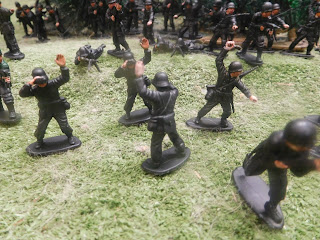Spacemen versus Cavemen
Human interstellar civilization had reached a number of peaks and troughs. Humanity had spread to other planets around alien stars. Methods of space travel had changed from when the first daring colonists had left in generation starships in 2202. Wormholes in space and ever faster speeds had left the original technologies behind. Humans had also extended their lifespans, at first by decades and then seemingly indefinitely. Nethertheless voluntary and imposed restrictions on births kept the Earth's population at a viable one billion. The life extension had occurred through genetic engineering as well as the use of artificial parts that also enhanced intelligence.
Yet humanity had suffered a major setback through a giant meteor hitting the earth in 2334. The merging of machine and human ceased and the population was reduced from billions to a few million living in underground cities. Pockets of technology survived and humans avoided falling into savagery. Populations grew quickly once food production through cloning of meat and plants and artificial 'sunlight' from the fusion reactors compensated for an Earth blanketed in dust for fifty years. The earlier genetic engineering meant continuation of longer lives and as restrictions on births were lifted humanity, after a few hundred years, humans approached their earlier numbers.
A second depopulation occurred, in 2664 with the accidental infestation of the alien Green Death from the Stresar binary star planetary system. Alien life forms were meant to be quarantined but the possibility of making new medicines, foods and stimulants were a big incentive for smugglers. The alien fungus, however, had its own ideas and escaped from its smugglers when a case of it was smashed in a hover car accident. The fungus spread by airborne spoors and caused its human hosts; skin to turn green and the victims suffered temporary and violent insanity. Fortunately only a third of the population died before a cure was found.
Humanity.s eventual return to the stars was slow but by 4000 the former colonies were re-visited. The humans left there had developed their own civilizations but most had lost their capacity for space flight. Some had regressed completely and some had even mutated into different forms of sapiens. On the planet Kristo around the star Copernicus there had been a significant change. Some unknown disaster had wiped out civilization. The planet was twice the size of Earth and consequently the gravity slowed movement. A mutant strain of giganticism had become dominant and the humans had grown at least twice the size of an Earth human. Their brains had also changed with a depletion in the frontal lobes but an increase in other areas associated with instinct. The resultant human strain was brutish but had survived the harsh conditions. The various dinosaur-like reptiles were hunted for their meat and skins. This was only fair as the same creatures, sometimes of immense size also found the humans tasty.
Encounters between newcomers and oldcomers on Kristo were often caustic. One of the newcomers is fortunate to have a gravity armoured suit to enhance his movement and combat viability. In two generations the primitive human strain was wiped out by the newcomers. However there are some scientists advocating genetic engineering to adapt colonists to the planet with more robust bodies but without sacrifice of intelligence.
Yet humanity had suffered a major setback through a giant meteor hitting the earth in 2334. The merging of machine and human ceased and the population was reduced from billions to a few million living in underground cities. Pockets of technology survived and humans avoided falling into savagery. Populations grew quickly once food production through cloning of meat and plants and artificial 'sunlight' from the fusion reactors compensated for an Earth blanketed in dust for fifty years. The earlier genetic engineering meant continuation of longer lives and as restrictions on births were lifted humanity, after a few hundred years, humans approached their earlier numbers.
A second depopulation occurred, in 2664 with the accidental infestation of the alien Green Death from the Stresar binary star planetary system. Alien life forms were meant to be quarantined but the possibility of making new medicines, foods and stimulants were a big incentive for smugglers. The alien fungus, however, had its own ideas and escaped from its smugglers when a case of it was smashed in a hover car accident. The fungus spread by airborne spoors and caused its human hosts; skin to turn green and the victims suffered temporary and violent insanity. Fortunately only a third of the population died before a cure was found.
Humanity.s eventual return to the stars was slow but by 4000 the former colonies were re-visited. The humans left there had developed their own civilizations but most had lost their capacity for space flight. Some had regressed completely and some had even mutated into different forms of sapiens. On the planet Kristo around the star Copernicus there had been a significant change. Some unknown disaster had wiped out civilization. The planet was twice the size of Earth and consequently the gravity slowed movement. A mutant strain of giganticism had become dominant and the humans had grown at least twice the size of an Earth human. Their brains had also changed with a depletion in the frontal lobes but an increase in other areas associated with instinct. The resultant human strain was brutish but had survived the harsh conditions. The various dinosaur-like reptiles were hunted for their meat and skins. This was only fair as the same creatures, sometimes of immense size also found the humans tasty.
Encounters between newcomers and oldcomers on Kristo were often caustic. One of the newcomers is fortunate to have a gravity armoured suit to enhance his movement and combat viability. In two generations the primitive human strain was wiped out by the newcomers. However there are some scientists advocating genetic engineering to adapt colonists to the planet with more robust bodies but without sacrifice of intelligence.
.JPG)


















Comments
Post a Comment